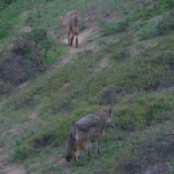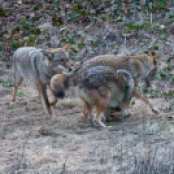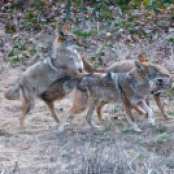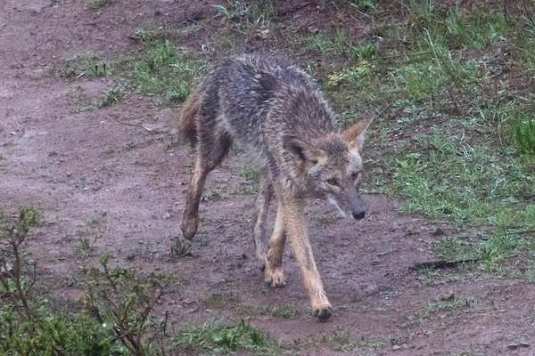What I see going on here is continued vying for preferential affection and attention from Dad. And Dad sure seems to be indulging these youngsters. He’s letting them climb all over him. I’ve divided up the photos into four groups to make this posting as clear as possible.
This behavior follows directly after the behavior I posted on February 4th: Vying for Dad’s Affection. The female youngster here, above, seems to have become insistent in her possessiveness of Dad: she puts her “paws on pop”. It reminds me of “Hop on Pop”. Notice her affectionate pull on Dad’s ear in the 3rd slide above. Almost all instances of “paws on another coyote” that I have seen have been a demonstration of dominance by a parent or dominant mate, or by one sibling towards another. But here it’s a youngster with paws on a father! Dad is indulging her — it’s probably simply “play dominance”, if even that!
The female falls off of Dad for a moment, but then gets up there again, as the male sibling looks on with interest. The male sibling, off to the side, doesn’t look too comfortable about what’s going on, as indicated by the position of his ears which are low and airplaned out to the sides.
And the female youngster doesn’t just put her paws on Dad, she actually hangs in there for some time! After a few minutes, as seen in the last slide of the three slides above, Dad slithers away from under her. Maybe enough is enough?
Oh, but now it’s the male youngsters turn! He actually “mounts” Dad in the traditional sense: “Hey, I can do this, too, in my own way.” Is he doing this competitively with his sister? Note that Dad puts up with it. He seems totally unphased. After all, these are just kids and.
The female youngster persists, getting on Dad again and pushing off her sibling! Back and forth between the two youngsters. Are they vying for Dad’s attention and vying for “possessing” him, does dominance in any form play into this, or is this just simple family closeness?



















 “I had a wonderful close encounter with a coyote in Palm Springs a few years ago and since then I have wanted to illustrate one. The coyote followed me and my dog Escher – who was very interested in it but I made him keep his distance. I also sometimes see them in the regional parks when hiking. The drawing is based on a photo by David Tunick.”
“I had a wonderful close encounter with a coyote in Palm Springs a few years ago and since then I have wanted to illustrate one. The coyote followed me and my dog Escher – who was very interested in it but I made him keep his distance. I also sometimes see them in the regional parks when hiking. The drawing is based on a photo by David Tunick.”




























